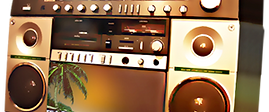
in Choral Music


Beatboxing

Beatboxing in choral music: Perspective case study exploring the use
of vocal percussion in the small vocal ensemble
INTRODUCTION
Vocal percussion is a technique whereby an individual creates sound with one’s mouth to imitate sounds in order to create or generate a rhythm. Beatboxing is often defined as a form of vocal percussion whereby the individual imitates the sound of a drum machine (Duchan, 2007; Kapur et al., 2004; Proctor et al., 2013; Stowell and Plumbley, 2008; TyTe & Defenicial, 2006). Beatboxing could be considered as an urban vocal percussion due to the hip-hop style of production (TyTe & Defenicial, 2006).
Vocalizing sound with the voice is as old as music itself with every culture having a different approach (Sinyor et al., 2005). In non-western music, the tradition of mouth percussion can be found in different cultures such as India and China (Proctor et al., 2013). Bols are mnemonic syllables primarily used in North Indian music to provide rhythmic patterns to the music (Wikipedia, 2013). The most common bols are dha, dhi/dhin, ti/tin, ra, ki, ta, na, tin, and te and are usually combined in four-beat patterns called thekas (Tyte & Defenicial, 2006). The konnakol is used in South India and involves the art of using the spoken word. Also used in the south is the solkattu, an art that uses a string of syllables that are performed while counting the tala by hand (Wikipedia, 2013). In China, the kouji translates as mouth skill where the individual mimics the sounds of everyday life, including the drums. Kouji is primarily used to complement the arts of storytelling, singing or acting (Wikipedia, 2013).
In North America, the use of vocal percussion can be traced back through African American roots. During the late 1880’s, black groups would sing their songs a cappella. These groups usually consisted of four people and became known as barbershop quartets. Using clicks and sharp breathing techniques, similar to the inward snare, the sound produced by the musicians helped to keep time in the music (Tyte & Defencial, 2006). In collegiate a cappella music, It is believed that the first ensemble emerged in 1909 with the Whiffenproofs, a seven-man group from Yale, who were influenced by the barbershop style (Duchan, 2007).
During the blues era, late nineteenth century, black slaves created music with their body and voice due to the lack of instruments readily available for them to use. The use of claps and clicks imitated drums while low humming provided the sound of the double bass. As blues became more mainstreamed, scatting and the imitation of trumpets and saxophones became popular vocal techniques in the music (Thompson, 2011; Tyte & Defencial, 2006).
After the blues era, vocal percussion was further developed in African-American culture through the doo-wop era (Tyte & Defencial, 2006). Words such as, doo, bum, bop, wah, dun, dum and den were pitched though vocals, imitating instruments and percussive rhythms. In the 1950’s, collegiate a cappella groups were influenced by the urban street corner sounds and continued to rise as a popular form of instrumental imitation in vocal production. While collegiate a cappella groups began to grow across America, professional a cappella groups also emerged, such as Manhatten Transfer (1972), the Nylons (1979), the Bobs (1982), Rockapella (1986), Take 6 (1988), and the House Jacks (1991). Through these professional groups, new sounds influenced vocal exploration in collegiate a cappella groups (Duchan, 2007).
The history of beatboxing is blurry (Tyte and Defencial, 2006). In the early 1980’s, four beatbox artists are credited with being pioneers of beatboxing: Darren 'Buffy' Robinson, Doug E Fresh, Biz Markie, and Leonardo Roman ‘Wise’ (Tyte and Defencial, 2006; Wikipedia, 2013). The four pioneer artists, as well as other prominent beatboxers of the 1980’s and 90’s are featured in a documentary filmed in 2002, Breath Control: The History of the Human Beat Box (Tyte and Defencial, 2006; Wikipedia, 2013).
The art form of beatboxing began to take on a different form in the 1990’s. In 1988, vocalist Bobby McFerrin showed the flexibility of the human voice as well as incorporating the use of body percussion in the song, Don’t Worry, Be Happy. In vocal jazz, soft background rhythmic sounds are performed by voices to keep time (Tyte and Defencial, 2006). In collegiate a cappella singing, background voices functioned as accompaniment, using the j syllable to emulate the sounds of the guitar or d syllables to emulate the piano (Duchan, 2007).
In the twenty-first century, Beatboxing was revitalized as an art form through performers such as Rahzel and Justin Timberlake (Tyte and Defencial, 2006). In an interview by Flyotw Ltd. (2012), Mc Xander shares that beatboxing has evolved into three main forms, battle style or competitive beatboxing, loopers, and ensemble beatboxers.
The Internet age has been very influential in the development of the art form. YouTube is not only a method of distributing tutorials and performances, it is a place where music can be watched, commented on, absorbed, and recreated (Thompson, 2011). The Internet also provides a place where beatboxers can come together and share in a virtual community, such as humanbeatbox.com (Tyte and Defencial, 2006).
There are questions in the a cappella community of the relationships between vocal percussion to beatboxing (Duchan, 2007). This paper presents the results of a multiple-case study design of beatboxers, small vocal a cappella ensembles, and composers, exploring how the vocal percussion art form of beatboxing is used in the music. The stories of the beatboxers, ensembles, and composers represent real-world experiences of the perceptions of beatboxing in choral music.
© 2013 by Keith Pender. All rights reserved.
Education 6915: Vocal and Choral Pedagogy